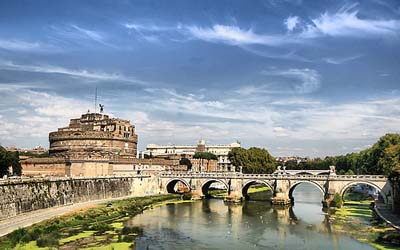Rome's Castel Sant'Angelo - a former papal fortress
 Rome - On the right bank of the river Tiber in Rome stands Castel Sant'Angelo, an ominous and apparently inaccessible castle that was once a refuge of popes.
Rome - On the right bank of the river Tiber in Rome stands Castel Sant'Angelo, an ominous and apparently inaccessible castle that was once a refuge of popes.
"It is one of our top attractions and no one should miss a visit," says art student Beatrice Bulzoni, who gives private, guided tours of the castle.
The Roman emperor, Hadrian, who ruled from 117 to 138, built the castle as his own mausoleum.
"A total of seven emperors were laid to rest here," tour guide Toni tells a group of visitors.
"At the end of the 16th century, when Pope Gregory I led a procession of penance against the plague past the fortress, Archangel Michael appeared and prophesied the end of the pestilence. That's how the castle got its name."
That legend, which passed down the generations to this day, is just one of many associated with Castel Sant'Angelo.
The author, Dan Brown, wrote about the castle in his book Angels and Demons.
"Tourists come here today looking for the fictional character Hassassin," says one of the castle's guards, Nicolo.
"Towards the end of the 14th century the pope's used the fortress as their own refuge," says Bulzoni.
In 1527, when German and Spanish mercenary pike men in the service of Charles V sacked Rome and carried out a massacre, Pope Clement VII and 13 of his cardinals were holed up inside the castle's thick walls.
The Roman Curia also used the castle whenever the Vatican, just one kilometre distant, became too dangerous.
Toni explains some of the castle's main architectural details: "The walls and their four bastions are 86 metres long. Inside is a circular structure that we call 'The Cylinder'. The upper level is 48 metres above ground and that is where the large bronze figure of the Archangel Michael stands."
The roof is reached via a spiral-shaped ramp inside the building which is used for events in the summer.
The roof offers an amazing view of the Vatican and Saint Peter's which is linked to the castle by the Passetto di Borgo, a secret passage that served as an escape route for the popes.
On the other side of the Tiber lie some of Rome's other historic sites such as the Colosseum, the Forum and Trevi Fountain.
The castle has a museum detailing the building's partly dark history. Sant'Angelo was the meeting place of the Inquisition which sentenced the philosopher, Giordano Bruno, to death.
Castel Sant'Angelo was also the spot where Galileo Galilee renounced his theory that the sun was the centre of the galaxy.
Composer Giacomo Puccini used the castle as a location in the last act of Tosca when the painter Mario Cavaradossi is executed under the statue of the archangel.
Internet: www. enit-italia. de, www. castelsantangelo. com. (dpa)